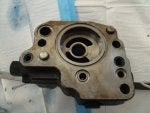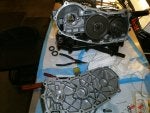Here are some other interesting things I have noticed about the sources of leaks on the 455 transaxle case.
First and foremost, while I do have much more experience than the average tractor owner having built race cars from tubing and sheet metal to having completed a wide range of automotive repairs including engine rebuilds, transmission replacements, 3rd member set ups and a range of ignition, wiring, carb and fuel projects, building race engines, etc., I am not a professional mechanic.
However, I do own a "real bitc-hin set of tools" and no, my father was not a television repair man (movie Fast Times at Ridgemont High reference). Here is my primary tool box of 3 which I have in my workshop. The other two are Craftsman Roller Cabinets mostly with repair items like all adhesives, rolls of wire and connectors, corded tools, etc.
![]()
Being organized and having a clean working environment is very important so I set up some aluminum work tables I have and covered them with hospital surgical cloths which I happen to have many of. I set up two of these tables, one for the actual working on the parts and the other for setting up a notebook computer and having the technical manuals handy, kind of my shop desktop.
![]()
I have to admit that as I studied all of the technical service manuals and the parts diagrams of every transaxle and hydro component, I became concerned that maybe I was undertaking something I would regret. The truth is, this has been much more straight forward and logical than I thought it would be. I have now opened up each side of the transaxle and I am replacing all seals, gaskets and checking everything for any signs of wear. I am not opening up the brake section of the transaxle as I have no reason to and it is rarely used so I doubt it is worn.
Thus far, I have found some signs of the sources of the leaks, including the seal out of place and the top vent was completely missing. But I have not encountered anything which I would consider "difficult" or that even required me to reference the manual to be able to reassemble it or disassemble it for that matter.
When you look at the parts diagrams of the hydro units and all of the valves and springs and checkballs, etc., it looks like it could easily turn into a mess. But in reality, for the most part, the multitude of parts are confined to very small areas. The major disassembly which occurs for pulling out the various gears, support bearings and seals is very straight forward and logical. I have disassembled the rear unit, other than the actual hydro valves themselves, and while I have a table full of parts, I have no doubt I can reassemble it without even looking at the parts diagrams and service manuals.
The engineers at Tuff Torque obviously built this unit to be very strong yet it's assembly is proving to be quite straight forward. If you have ever disassembled a 3 or 4 speed manual transmission from the 50's thru early 80's, this reminds me of the logical structure which those units also have.
I guess the message which I want to make sure those of you following this gain from my experience is that if you have decent mechanical skills, a reasonable collection of tools (internal and external snap ring pliers, torque wrenchs in Neuton Meters, metric wrenchs and sockets and some small tools for correctly removing gaskets and seals) then you should be able to handle this project.
Take pictures of each step before you disassemble it so you have a reference. Keep your bolts and parts organized as you take them off so you can easily locate them. I have my wife save cool whip plastic bowls and such thru out the year and after she pulls them from the dishwasher, I put them in a cabinet in my shop. That way, as I am disassembling something, I use a seperate bowl for each item. I have one for body hardware, one for the wheel bolts, one for the axle bolts and so on. I mark them on the inside edge with a black marker so as I handle them, I don't smear the writing.
It is just a logical process and an organized one. I power wash each part as I disassemble them and then once clean, I repaint each part before or during it's reassembly. This adds a lot of time to this but I am not doing this job on a flat rate labor basis. I am restoring my tractor as I repair it so when I am done, it will look like new. If you simply want to repair it, then no need to bother with the extensive cleaning and painting like I am doing. I am even painting the rear wheels after I cleaned them and then scuffed them up with 220 grit sandpaper to hold the new paint. So I am not documenting my hours on this project but I do have a good idea of the total time necessary to facilitate the transaxle rebuilding.
I will keep you posted. If anyone needs a specific photo of anything inside the transaxle or otherwise in the proect let me know and if I don't have it, I will see if I can get it for you. Already, I have taken over 75 different pictures to document this step by step but also to have before and after pictures. I am going to take a good hard look at the body tomorrow and decide whether I want to paint it myself or send it out to a body shop for them to paint and apply clear coat.
Let me know if you have any questions or if I can provide insight on this project. So far, I am very pleased with the way it is going and the specific leaks which I have found and repaired. Check out the appearance of these PTO Mid output shaft seals, new and old. It is interesting how much of the iside wear edge of the seal actually wears away with use..
![]()
Tomorrow's another day.
![]()

























